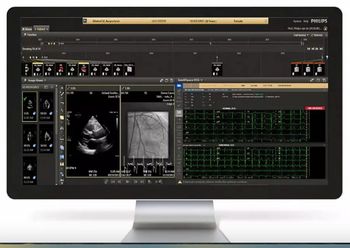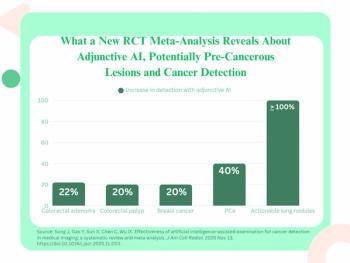
Faster temporal resolution takes on all heart rates
Coronary CT angiography is one of the most promising new applications of CT technology. Despite the increasing number of detectors in CT scanners, however, coronary CT imaging had not solved the key issue: dealing with a structure that is in almost constant motion. That is, until the advent of dual source CT.
Coronary CT angiography is one of the most promising new applications of CT technology. Despite the increasing number of detectors in CT scanners, however, coronary CT imaging had not solved the key issue: dealing with a structure that is in almost constant motion. That is, until the advent of dual source CT.
On the best systems available prior to the dual-source scanner, temporal resolution was 165 msec, requiring a heart rate of 75 bpm or less to obtain technically satisfactory images. This situation required the use of premedication with beta blockers in many patients. By using two x-ray sources, the dual-source scanner can achieve a temporal resolution of 83 msec, allowing scanning without beta blockers at essentially all clinically relevant heart rates. This advance has major implications for patient handling.
In our independent outpatient center, we run a full CT schedule from 7 a.m. to 10 p.m., scheduling patients in 10-minute increments, with occasional downtime slots to allow for STAT cases and catch-up. On average, we scan four to five CT patients per hour. Because we no longer use beta blockers for the majority of our coronary CTA patients, we schedule these exams into routine patient slots and perform from five to eight of them per day. We limit beta blockade to fewer than 5% of our patients, generally those who require the "obesity" protocol on the DSCT, where the full 83 msec temporal resolution is not achieved.
Initial patient setup occurs in a dedicated prep area, which is used by all our CT and MR patients. A nurse interviews the patient, briefs the patient on the procedure, and inserts an intravenous line. The patient is then escorted to the scanner, ECG leads placed, and the scan performed. Immediately after the scan, the patient is escorted back to the prep area. This process minimizes time in the scan room, allowing for optimal throughput.
The scan series includes an anteroposterior topogram, a low-dose scan to localize and assess the degree of coronary calcium, a timing run, and the CTA acquisition.
Our CTA acquisition protocols vary depending on indication, patient age, patient body habitus, and heart rate. In patients with heart rates above 75 bpm, we use a pulse window of 30% to 80%. At these heart rates, images in late systole are often optimal for reconstruction, especially of the right coronary. At rates below 75 bpm, we limit the pulse window to 60% to 80%.
The pulse window can be adjusted to provide limited image quality to allow for full function analysis or can be reduced to 4% of the tube output, which lowers dose more but does not allow for function. For rates below 60 bpm, we limit the pulse window to 60% to 70%. The system automatically determines the best diastolic and systolic phases for reconstruction.
Postprocessing is performed by a dedicated 3D tech who creates volume-rendered (Figure 3) and maximum intensity projection images, performs ejection fraction calculations, and bookmarks the extracted coronary tree for future access by the radiologist. If necessary, the 3D tech will interact with the scanner to perform ECG editing of ectopic beats.
The interpreting physician initially reviews the scan via a thin-client solution on our PACS. In many cases, the scan can be interpreted directly from this tool. If the radiologist requires more advanced stenosis evaluation and quantification tools, he or she moves to the workstation, preloads the bookmarked images from the 3D tech, and analyzes the case. Reports are generated from a standard template on a voice recognition system allowing reproducibility for referring clinicians.
The procedure outlined above has allowed our center to implement coronary CTA in a busy diagnostic imaging center while maximizing patient throughput and radiologist efficiency. Future trends in reimbursement strongly suggest that only a system that maximizes scan efficiency will allow CCTA to achieve its full potential.
Dr. Muhr is a radiologist with South Jersey Radiology Associates in Voorhees, NJ.
Newsletter
Stay at the forefront of radiology with the Diagnostic Imaging newsletter, delivering the latest news, clinical insights, and imaging advancements for today’s radiologists.

























